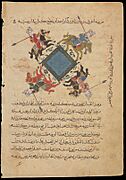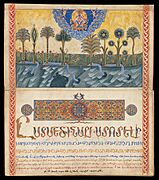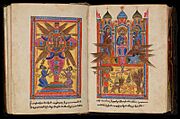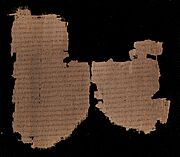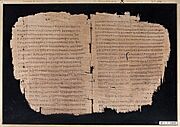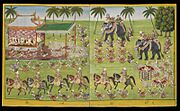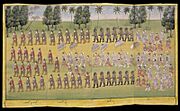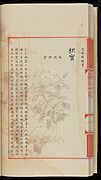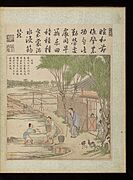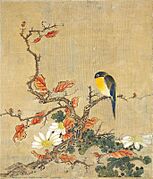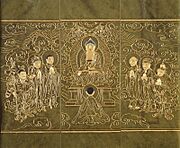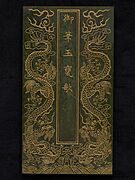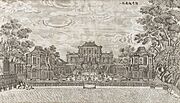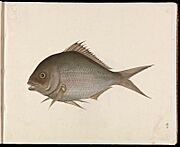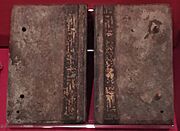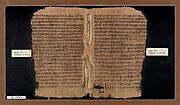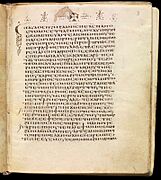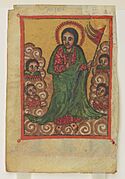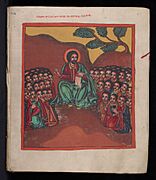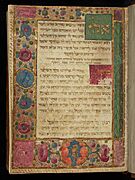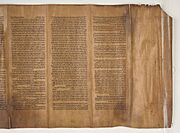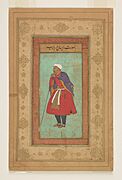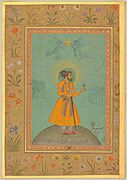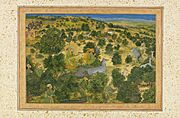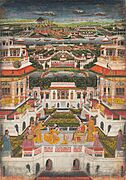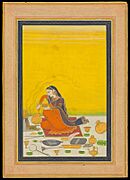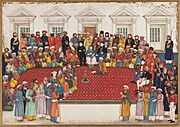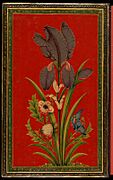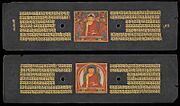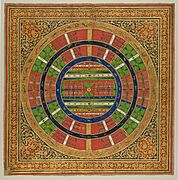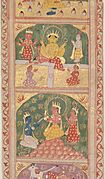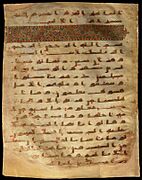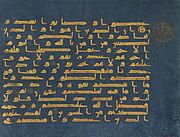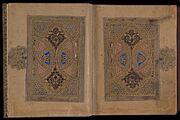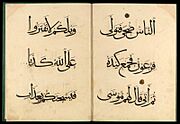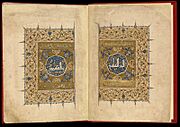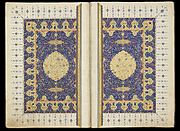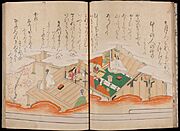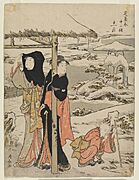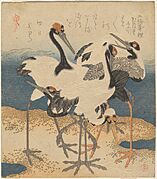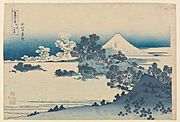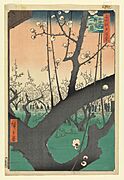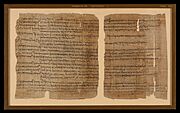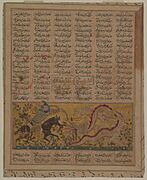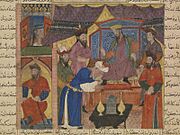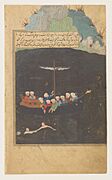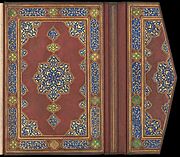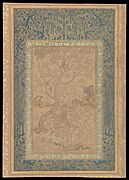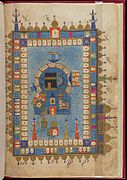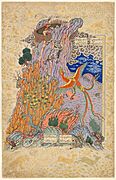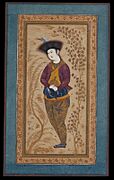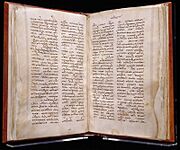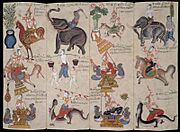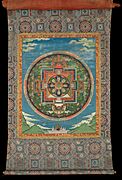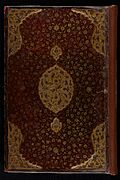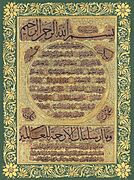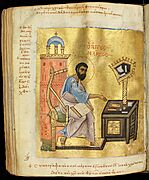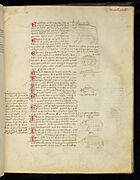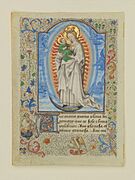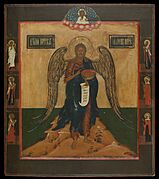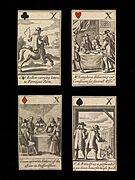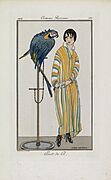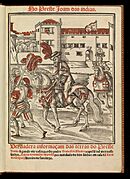Chester Beatty Library facts for kids
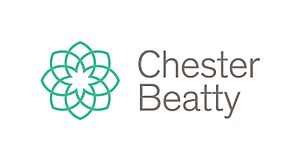 |
|
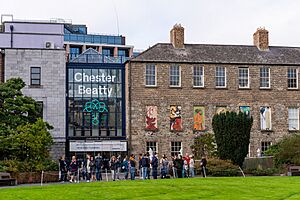
Entrance of the Chester Beatty, Dublin, Ireland
|
|
| Former name | Chester Beatty Library |
|---|---|
| Established | 1953 |
| Location | Dublin Castle, Dublin |
| Type | Art Museum, library, Visitor Attraction |
| Collections | The Chester Beatty is Ireland’s leading museum of world cultures, caring for and sharing an extraordinary collection of manuscripts, rare books, miniature paintings and other decorative objects that are of world importance. With collections from Europe, the Middle East and across Asia, the role of the museum is unique in Ireland’s cultural landscape. |
| Collection size | approx 25,000 |
| Visitors | 530,000 (2024) |
| Founder | Sir Alfred Chester Beatty |
| Public transit access | Luas, Dublin Bus, DART |
The Chester Beatty is a famous museum and library located in Dublin Castle, Ireland. It was first opened in 1953 to display the amazing collections of Sir Alfred Chester Beatty, a wealthy mining expert. The museum you see today opened its doors on February 7, 2000. It was even named the European Museum of the Year in 2002!
The Chester Beatty is a top place for learning about ancient texts and art. It holds one of the most important collections of items from Western, Islamic, and East & South East Asian cultures. The museum also hosts many special exhibitions. These often feature artworks borrowed from other museums around the world. You can find truly priceless objects here. These include one of the last remaining copies of the first illustrated Life of the Prophet and the Gospel of Mani. This Gospel is one of the very last surviving Manichaean scriptures.
Contents
- Exploring the Chester Beatty Galleries
- Amazing Collections from Around the World
- Collection Highlights: A Closer Look
- Arabic Collection
- Armenian Collection
- Biblical Papyri Collection
- Burmese Collection
- Chinese Collection
- Coptic Collection
- Egyptian Papyrus Collection
- Ethiopian Collection
- Hebrew Collection
- Indian Collection
- Indian (Non-Mughal) Collection
- Islamic Collection
- Japanese Collection
- Papyrus Collection
- Persian Collection
- Syriac Collection
- Thai Collection
- Tibetan Collection
- Turkish Collection
- Western Collection
- Western Miscellaneous Collection
- Western Prints and Drawings Collection
- Other Interesting Items
- See also
Exploring the Chester Beatty Galleries
The museum's collections are shown in two main areas. These are called "Sacred Traditions" and "Arts of the Book." Both areas display incredible items. You can see old handwritten books, tiny paintings, and rare printed books. There are also drawings and decorative art from Persian, Islamic, East Asian, and Western cultures.
Amazing Collections from Around the World
Western Treasures
The Western Collection has many beautiful illuminated manuscripts. These are handwritten books decorated with gold and bright colors. It also includes rare printed books and old master prints and drawings. The Christian items in this collection come from many different places. They include texts written in languages like Armenian, Greek, and Latin. The museum has one of the largest collections of papyri in the world. Papyri are ancient papers made from plants. This collection includes some of the oldest Christian artifacts known today.
Islamic Art and Texts
The Islamic Collection is divided into several parts. These include Arabic, Persian, Turkish, and Mughal-Era Indian items. The Arabic texts cover many topics. These are religion, history, medicine, and math. Some of the most beautiful miniature paintings from imperial Mughal albums are here. These albums are called Muraqqa'. You can often see the Ibn al-Bawwab Qur'an on display. This holy book was copied by one of the greatest Islamic calligraphers (people who write beautifully).
Persian Masterpieces
The Persian collection features many miniature paintings and manuscripts. These include works by famous Persian poets like Ferdowsi and Nizami.
East Asian Wonders
The East Asian Collection has a huge number of carved snuff bottles. These are small, decorative bottles used for holding powdered tobacco. It also has beautiful Japanese art. This includes long picture-scrolls painted in the 17th century by Kanō Sansetsu.
Collection Highlights: A Closer Look
Arabic Collection
-
'Manual on the Arts of Horsemanship' by al-Aqsara'i. Cairo, 1366.
Armenian Collection
-
Armenian Gospel Book made in Isfahan in 1655
Biblical Papyri Collection
-
Fragments of Papyrus 46
Burmese Collection
-
Court amusements and ceremonies. Myanmar, 19th century
Chinese Collection
-
Chapters 10,110 to 10,112 of the 'Great encyclopaedia of the Yongle Reign'
-
'Diamond Sutra' written in Chinese, engraved and gilded on fifty-three folios of nephrite jade. 1732
Coptic Collection
-
Papyrus with the fragments of the Book of Joshua. Egypt, 4th century
-
Coptic manuscript of the 'Pauline Epistles & Gospel of John'. Egypt, circa 600
Egyptian Papyrus Collection
-
Book of the Dead of Lady Neskhons. Egypt, c. 300 BC
Ethiopian Collection
Hebrew Collection
Indian Collection
-
Portrait of Raisal Darbari. Allahabad, circa 1600-1605
-
Jujhar Singh Bundela kneels in submission to Shah Jahan by Bichitr, circa 1630
-
Awrangzib Hunts Nilgais. Circa 1660
-
Women on a palace terrace with a panoramic view. Faizabad, 1770
Indian (Non-Mughal) Collection
Islamic Collection
Japanese Collection
-
17th century manuscript of The Tale of Genji
-
Seven-mile beach in Sagami province (Sōshū Shichiri-ga-hama). Woodblock print from the series Thirty-six Views of Mount Fuji (Fugaku sanjūrokkei) by Katsushika Hokusai, c. 1831
-
Plum Park in Kameido, woodblock print from the series One Hundred Famous Views of Edo (Meisho Edo hyakkei) by Utagawa Hiroshige, 1857
Papyrus Collection
-
Official correspondence of the Strategos of Panopolis concerning the preparations for the forthcoming visit of Diocletian. Panopolis, 298
Persian Collection
-
The rescue at sea by Amir Khalil. From Prince Baysunghur's Rose Garden (Gulistan). Herat, 1427
-
Filigree leather book cover, for the Five Poems (Khamsa) of Amir Khusrau. Herat, 1485
-
Zal Rescued by the Simurgh by Sadiqi Beg. Miniature from the Shahnameh commissioned by Shah Abbas I. Probably Qazvin, between 1590 and 1600
-
Young man in a fur hat by Reza Abbasi. Isfahan, between 1600 and 1625
Syriac Collection
-
Parchment manuscript of the Ephrem's Commentary on the Diatessaron and an exchange of letters between Severus of Antioch and Julian of Halicarnassus. Egypt, late 5th or early 6th century and 8th or 9th century
Thai Collection
-
Fortune-Telling Manual (Phrommachat) with the twelve animals of the Thai zodiac and their associated attributes, avatars and plants. Thailand, c. 1845
Tibetan Collection
Turkish Collection
-
Binding from "The Cream of Histories" (Zubdat al-tawarikh). Istanbul, 1585-1590
-
Description of the Prophet (Hilya al-nabi), by Hâfiz Osman. Istanbul, 1691/1692
Western Collection
Western Miscellaneous Collection
-
Triptych with Virgin and Child and St Nicholas. Russia, c. 1800
-
St John the Forerunner. Russia, 19th century
Western Prints and Drawings Collection
-
Popish Plot Playing Cards, after Francis Barlow. England, c. 1679
Other Interesting Items
-
First edition of 'The Prester John of the India' (Ho Preste Joam das Indias) by Francisco Álvares. Lisbon, 1540
-
Embroidered Binding. Possibly an Italian 18th-century binding of white silk Damask. The Book of Common Prayer and administration of the sacraments
-
Art Nouveau binding by Charles Meunier. Paris, 1897
See also
 In Spanish: Biblioteca Chester Beatty para niños
In Spanish: Biblioteca Chester Beatty para niños


